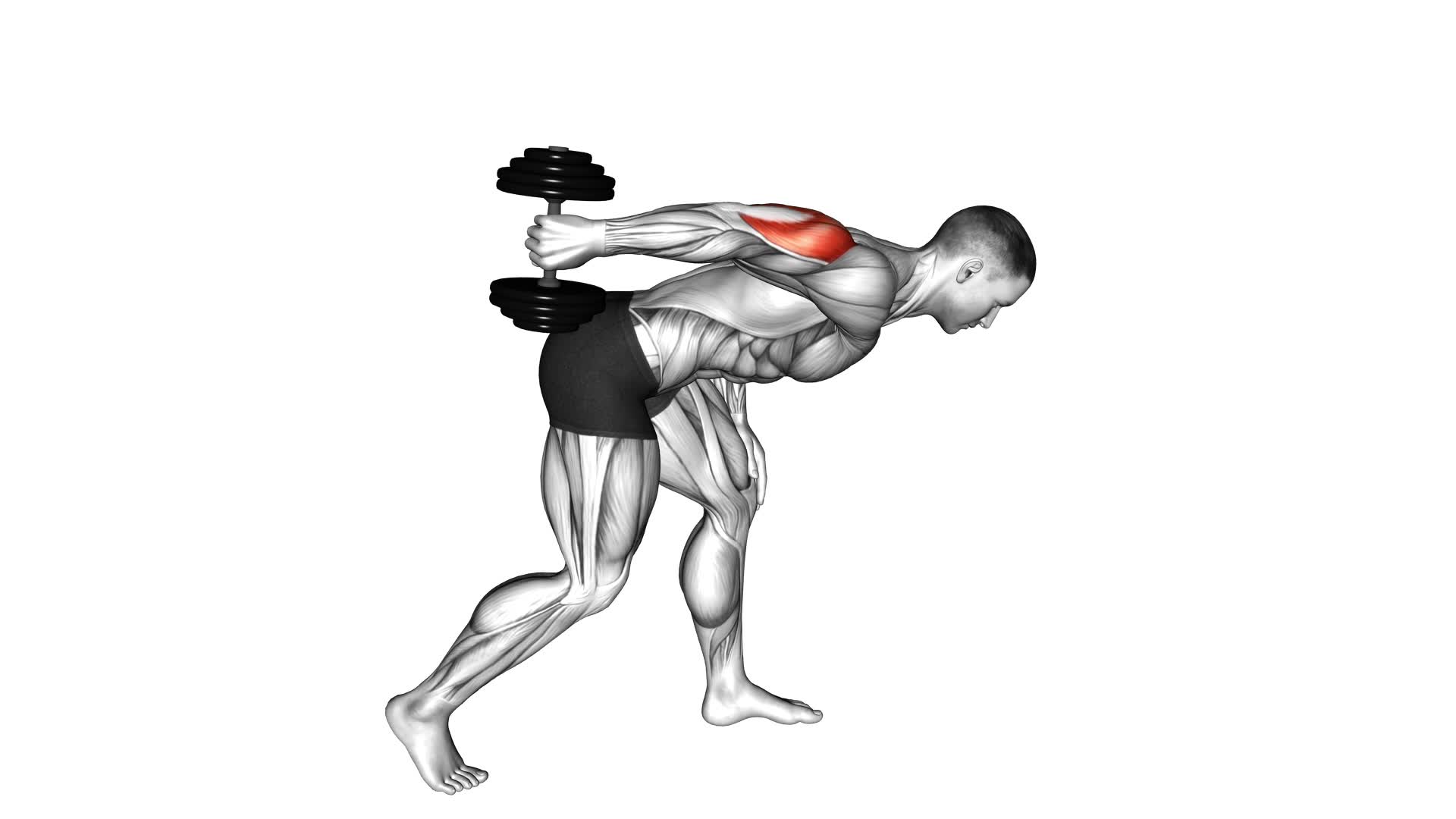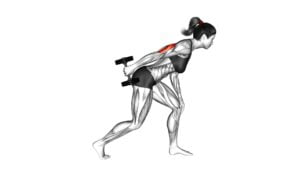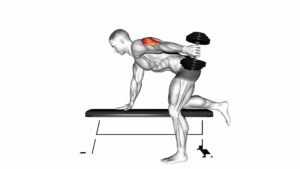Dumbbell One Arm Kickback – Video Exercise Guide & Tips

Are you looking to tone your triceps and build upper body strength? The Dumbbell One Arm Kickback is the perfect exercise for you!
Watch This Exercise Video
In this video exercise guide, we'll show you the proper technique and common mistakes to avoid.
Plus, we'll share variations and tips to help you get the most out of your workout.
Get ready to see results with this effective and efficient exercise.
Let's kickback those triceps!
Key Takeaways
- The dumbbell one arm kickback targets and strengthens the triceps muscle.
- It engages muscles of the shoulder and upper back for a comprehensive upper body workout.
- It improves posture and stability by strengthening muscles that support the shoulder joint.
- Common mistakes to avoid include using momentum instead of relying on tricep contraction, allowing the elbow to flare out to the side, using too much weight and sacrificing proper form, and not fully extending the arm at the top of the movement.
Benefits of the Dumbbell One Arm Kickback
One major benefit of the Dumbbell One Arm Kickback is that it targets and strengthens your triceps muscle. This exercise specifically focuses on the back of your upper arm, helping to tone and define the triceps. By performing the Dumbbell One Arm Kickback, you activate the triceps muscle, which is responsible for extending the elbow joint. This muscle activation is crucial for building strength and improving overall arm functionality.
In addition to targeting the triceps, the Dumbbell One Arm Kickback also engages the muscles of the shoulder and upper back, providing a comprehensive upper body workout. This exercise can help improve posture and stability by strengthening the muscles that support the shoulder joint.
Another benefit of the Dumbbell One Arm Kickback is its versatility. It can be performed with various weights and can easily be modified to suit different fitness levels. Whether you're a beginner or an advanced lifter, this exercise can be adapted to challenge your muscles and help you achieve your fitness goals.
Now that you understand the benefits of the Dumbbell One Arm Kickback, let's move on to discussing the proper technique for performing this exercise.
Proper Technique for the Dumbbell One Arm Kickback
To perform the Dumbbell One Arm Kickback with proper technique, position yourself in a standing position with a dumbbell in one hand. This exercise primarily targets the triceps, while also engaging the shoulders and upper back muscles for stability. Start by standing with your feet shoulder-width apart, knees slightly bent, and your back straight. Hold the dumbbell with an overhand grip and bring it close to your chest.
Extend your arm backward, keeping your elbow close to your body, until your arm is fully extended. Squeeze your triceps at the top of the movement, and then slowly lower the dumbbell back to the starting position. It's important to focus on maintaining a stable core throughout the exercise and to avoid using momentum to swing the weight.
Incorporating the dumbbell one arm kickback into your workout routine can help increase triceps strength and definition. You can perform this exercise as part of an upper body workout, either on its own or in combination with other exercises such as push-ups or overhead presses. Aim for 3-4 sets of 10-12 repetitions on each arm, using a weight that challenges you but allows you to maintain proper form.
As with any exercise, it's important to listen to your body and start with a weight that's appropriate for your fitness level. By focusing on proper technique and gradually increasing the weight over time, you can maximize the benefits of the dumbbell one arm kickback.
Transitioning into the subsequent section about common mistakes to avoid during the dumbbell one arm kickback, it's important to be aware of these errors to ensure you're getting the most out of your workout and avoiding potential injuries.
Common Mistakes to Avoid During the Dumbbell One Arm Kickback
When performing the Dumbbell One Arm Kickback, it's important to be mindful of common mistakes that can hinder your progress and increase the risk of injury. One common mistake to avoid is using momentum to swing the weight up instead of relying on the contraction of your tricep muscles. This can diminish the effectiveness of the exercise and put strain on other muscle groups.
Another mistake is allowing your elbow to flare out to the side instead of keeping it close to your body. This can also reduce the effectiveness of the exercise and increase the risk of shoulder injury.
Additionally, using too much weight can cause you to sacrifice proper form and technique. It's better to start with lighter weights and focus on performing the exercise correctly before increasing the weight.
Lastly, not fully extending your arm at the top of the movement is a common mistake. This limits the range of motion and reduces the effectiveness of the exercise.
By avoiding these common mistakes and focusing on proper technique, you can maximize the benefits of the Dumbbell One Arm Kickback.
Now, let's move on to the next section to explore variations of this exercise.
Variations of the Dumbbell One Arm Kickback
To add variety to your workout routine, try incorporating different variations of the Dumbbell One Arm Kickback. Here are three variations that you can try:
- Overhead Triceps Extension: Hold a dumbbell with both hands and extend it overhead. Keep your elbows close to your head and lower the weight behind your head, feeling the stretch in your triceps. Extend your arms back up to the starting position and repeat.
- Bench Dips: Sit on the edge of a bench with your hands gripping the edge beside you. Extend your legs out in front of you and lower your body by bending your elbows. Go as low as you comfortably can, feeling the contraction in your triceps. Push yourself back up to the starting position and repeat.
- Close Grip Push-Ups: Get into a push-up position with your hands placed close together, directly under your shoulders. Lower your body down, keeping your elbows close to your sides. Push yourself back up to the starting position, feeling the burn in your triceps. Repeat for the desired number of reps.
Incorporating the Dumbbell One Arm Kickback into a full body workout routine is simple. Include it as one of your triceps exercises, performing 2-3 sets of 10-12 reps. You can combine it with other exercises like push-ups, overhead presses, and triceps dips to target your triceps from different angles and maximize your results.
Remember to always use proper form and choose weights that challenge you but still allow you to maintain good technique.
Tips for Getting the Most Out of the Dumbbell One Arm Kickback
Maximize your results with the Dumbbell One Arm Kickback by focusing on proper form and using a weight that challenges your triceps. To maximize effectiveness and avoid injury, follow these tips:
- Start with the right weight:
Choose a dumbbell that challenges your triceps but still allows you to maintain proper form. Using a weight that's too heavy can compromise your form and increase the risk of injury.
- Maintain proper form:
Stand with your feet shoulder-width apart, knees slightly bent. Keep your back straight and core engaged throughout the exercise. Avoid swinging your arm or using momentum to lift the weight. Focus on isolating your triceps and keeping your elbow close to your body.
- Control the movement:
Slowly extend your arm behind you, while keeping your upper arm parallel to the floor. Pause at the top of the movement and squeeze your triceps. Then, slowly lower the weight back to the starting position. Avoid rushing through the exercise and maintain control throughout the movement.
- Listen to your body:
Pay attention to any discomfort or pain during the exercise. If you experience any pain, stop immediately and consult a fitness professional or healthcare provider. It's important to prioritize your safety and well-being while performing any exercise.
Frequently Asked Questions
How Many Sets and Repetitions Should I Do for the Dumbbell One Arm Kickback?
To properly perform the dumbbell one arm kickback, you should focus on maintaining proper form and technique.
This exercise primarily targets your triceps while also engaging your shoulders and core.
As for the number of sets and repetitions, it's recommended to start with 2-3 sets of 10-12 repetitions per arm.
However, it's important to listen to your body and gradually increase the intensity as you become stronger and more comfortable with the exercise.
Can I Do the Dumbbell One Arm Kickback With Both Arms at the Same Time?
Yes, you can do the dumbbell one arm kickback with both arms at the same time. However, it's recommended to start with one arm at a time to ensure proper form and execution.
This exercise targets your triceps and can be done with variations such as using different weights or angles.
It's important to avoid common mistakes like swinging your body or using momentum. Focus on maintaining control and engaging your triceps throughout the movement.
Is It Necessary to Use a Dumbbell for the One Arm Kickback or Can I Use Other Equipment?
You don't have to use a dumbbell for the one arm kickback. There are alternative equipment options available.
However, using a dumbbell has its benefits. It allows for better control and targeting of the triceps muscles. Plus, it provides resistance to help build strength and muscle definition.
Can the Dumbbell One Arm Kickback Help Me Build Muscle Mass?
Yes, the dumbbell one arm kickback can definitely help you build muscle mass. By incorporating this exercise into your workout routine, you can target and isolate your triceps, resulting in increased strength and muscle growth.
To get the maximum results, make sure to perform the exercise with proper form. Keep your back straight, hinge at the elbow, and fully extend your arm backward.
Don't forget to choose a challenging weight that allows you to complete the desired number of reps with proper form.
Are There Any Modifications or Alternatives for People With Wrist or Shoulder Injuries?
If you have wrist or shoulder injuries, there are modifications and alternatives you can try instead of the dumbbell one arm kickback. These modifications can help you work on building muscle mass while reducing strain on your wrists and shoulders.
Additionally, the dumbbell one arm kickback targets different muscle groups, including the triceps and shoulders. By modifying the exercise or trying alternative exercises, you can still achieve the benefits of strengthening these muscle groups without exacerbating your injuries.
Conclusion
In conclusion, the dumbbell one arm kickback is a highly effective exercise for targeting the triceps muscles. By following proper technique and avoiding common mistakes, you can maximize the benefits of this exercise.
Additionally, there are variations available to add variety and challenge to your workout. Remember to start with lighter weights and gradually increase as your strength improves.
Incorporate the dumbbell one arm kickback into your routine for stronger and more defined triceps.

Author
Years ago, the spark of my life’s passion ignited in my mind the moment I stepped into the local gym for the first time. The inaugural bead of perspiration, the initial endeavor, the very first surge of endorphins, and a sense of pride that washed over me post-workout marked the beginning of my deep-seated interest in strength sports, fitness, and sports nutrition. This very curiosity blossomed rapidly into a profound fascination, propelling me to earn a Master’s degree in Physical Education from the Academy of Physical Education in Krakow, followed by a Sports Manager diploma from the Jagiellonian University. My journey of growth led me to gain more specialized qualifications, such as being a certified personal trainer with a focus on sports dietetics, a lifeguard, and an instructor for wellness and corrective gymnastics. Theoretical knowledge paired seamlessly with practical experience, reinforcing my belief that the transformation of individuals under my guidance was also a reflection of my personal growth. This belief holds true even today. Each day, I strive to push the boundaries and explore new realms. These realms gently elevate me to greater heights. The unique combination of passion for my field and the continuous quest for growth fuels my drive to break new ground.







